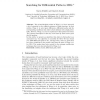Free Online Productivity Tools
i2Speak
i2Symbol
i2OCR
iTex2Img
iWeb2Print
iWeb2Shot
i2Type
iPdf2Split
iPdf2Merge
i2Bopomofo
i2Arabic
i2Style
i2Image
i2PDF
iLatex2Rtf
Sci2ools
96
Voted
FSE
2006
Springer
2006
Springer
Searching for Differential Paths in MD4
The ground-breaking results of Wang et al. have attracted a lot of attention to the collision resistance of hash functions. In their articles, Wang et al. give input differences, differential paths and the corresponding conditions that allow to find collisions with a high probability. However, Wang et al. do not explain how these paths were found. The common assumption is that they were found by hand with a great deal of intuition. In this article, we present an algorithm that allows to find paths in an automated way. Our algorithm is successful for MD4. We have found over 1000 differential paths so far. Amongst them, there are paths that have fewer conditions in the second round than the path of Wang et al. for MD4. This makes them better suited for the message modification techniques that were also introduced by Wang et al.
Related Content
| Added | 23 Aug 2010 |
| Updated | 23 Aug 2010 |
| Type | Conference |
| Year | 2006 |
| Where | FSE |
| Authors | Martin Schläffer, Elisabeth Oswald |
Comments (0)

